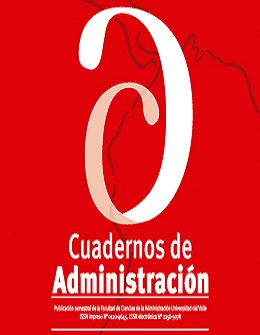Working conditions and burnout in personnel of a Mexican government agency
Main Article Content
Good working conditions help prevent mental health risks, such as organizational burnout, which is understood as the combination of exhaustion, depersonalization, and dissatisfaction with achievement. This research work was developed in a Mexican government agency dedicated to mediation to solve problems between individuals. The objective was to analyze the relationship between the different dimensions of working conditions and occupational burnout to identify potential risks and stressors that could lead to occupational burnout. The working conditions questionnaire (Blanch et al., 2010) and the scale for occupational burnout (Uribe, 2010) were used. Spearman correlations, one-way analysis of variance, and path analysis were performed to test the hypothesis. Results (r2 = .33) confirmed a negative correlation between the components of working conditions and occupational burnout (β = -. 57), also identifying a positive covariation between the development component of the working conditions and the exhaustion of occupational burnout (β = .48), obtaining a model of trajectories with acceptable goodness of fit (Chi2 = 52.09, df = 24, p = .001; RMR = .052; GFI =. 91; CFI = .94; RMSEA = .09, 90% CI [.06, .13]). The importance of promoting favorable working conditions is discussed, seeking a balance between promoting the development of employees and their daily responsibilities to avoid the stress that could affect their health, well-being, and performance.
Andrade, Y. (2011). La justicia alternativa en México. Una visión a través de los derechos humanos. IUS Revista Jurídica, VIII(42). https://ti.unla.edu.mx/iusunla42/reflexion/LA%20JUSTICIA%20ALTERNATIVA%20EN%20MEXICO%20ANDRADE%20MORALES%20Yurisha.htm
Arbuckle, J. L. (2014). Amos (Version 23.0) [Computer Program]. IBM SPSS. https://www.ibm.com/es-es/products/structural-equation-modeling-sem
Blanch, J., Sahagún, M., y Cervantes, G. (2010). Estructura factorial del Cuestionario de Condiciones de Trabajo. Revista de Psicología del Trabajo y de las Organizaciones, 26(3), 175-189. https://doi.org/10.5093/tr2010v26n3a2 DOI: https://doi.org/10.5093/tr2010v26n3a2
Burke, R. (1987). Burnout in police work: An examination of the Cherniss model, Group and Organization Studies, 12, 174-188. DOI: https://doi.org/10.1177/105960118701200205
Cacua-Barreto, L., Carvajal-Villamizar, H., y Hernández, N. (2017). Condiciones de trabajo y su repercusión en la salud de los trabajadores de la plaza de mercado la Nueva Sexta, Cúcuta. Psicoespacios, 11(19), 99-119. https://doi.org/10.25057/issn.2145-2776 DOI: https://doi.org/10.25057/21452776.887
Díaz, F., Gómez, I. (2016). La investigación sobre el síndrome de burnout en latinoamérica entre 2000 y el 2010. Psicología desde el Caribe, 33(1), 113-131. http://www.scielo.org.co/pdf/psdc/v33n1/v33n1a09.pdf DOI: https://doi.org/10.14482/psdc.33.1.8065
Fernández, M. (2017). Relación entre desgaste ocupacional y manifestaciones psicosomáticas en una muestra de docentes colombianos de la ciudad de Santa Marta. Archivos de Medicina, 17(1), 78-90. https://doi.org/10.30554/archmed.17.1.1910.2017 DOI: https://doi.org/10.30554/archmed.17.1.1910.2017
Fuster-Guillén, D., Jara-Jara, N., Ramírez-Asís, E., Maldonado-Leyva, H., Norabuena, R., y García, A. (2019). Desgaste ocupacional en docentes universitarios mediante el modelo factorial confirmatorio. Propósitos y Representaciones, 7(3), 198-230. http://dx.doi.org/10.20511/pyr2019.v7n3.389 DOI: https://doi.org/10.20511/pyr2019.v7n3.389
Gil-Monte, P. (2002). Validez factorial de la adaptación al español del Maslach Burnout Inventory-General Survey. Salud Pública de México, 44, 33-40. http://www.scielo.org.mx/pdf/spm/v44n1/8559.pdf DOI: https://doi.org/10.1590/S0036-36342002000100005
Kline, R. (2016). Principles and practice of structural equation modeling. The Guilford Press. https://www.guilford.com/books/Principles-and-Practice-of-Structural-Equation-Modeling/Rex-Kline/9781462523344
Lauracio, C., Lauracio, T. (2020). Síndrome de Burnout y desempeño laboral en el personal de salud. Revista Innova Educación, 2(4). https://doi.org/10.35622/j.rie.2020.04.003 DOI: https://doi.org/10.35622/j.rie.2020.04.003
Lévy, J. P., Varela, J. (2003). Análisis multivariable para las Ciencias Sociales. Pearson Prentice Hall.
Martínez, A. (2010). El síndrome de Burnout. Evolución conceptual y estado actual de la cuestión. Vivat Academia, 112, 1-40. https://doi.org/10.15178/va.2010.112.42-80 DOI: https://doi.org/10.15178/va.2010.112.42-80
Maslach, C., Jackson, S., & Leiter, M. (1997). Maslach Burnout Inventory. Consulting Psychologists Press.
Molina, C. (2020). La salud psicosocial, una condición de trabajo decente: el “neo-taylorismo digital” en clave de (pérdida de) bienestar. En M. Correa, M. Quintero (Coords.), Los nuevos retos del trabajo decente: la salud mental y los riesgos psicosociales (pp. 8-37). Universidad Carlos III, Madrid. https://e-archivo.uc3m.es/bitstream/handle/10016/29725/nuevos_retos_trabajo_2020.pdf
Moreno, J., Trujillo, M., & Lámbarry, F. (2019). The prevalence of occupational burnout in the government auditors of Mexico, a gender perspective. Contaduría y Administración, 64(4), 1-22. http://dx.doi.org/10.22201/fca.24488410e.2018.1475 DOI: https://doi.org/10.22201/fca.24488410e.2018.1475
Organización Internacional del Trabajo [OIT]. (9 de agosto de 2004). ¿Qué es el trabajo decente? https://www.ilo.org/americas/sala-de-prensa/WCMS_LIM_653_SP/lang--es/index.htm
Organización Mundial de la Salud [ONS]. (2004). Promoción de la salud mental. ONS. http://www.asmi.es/arc/doc/promocion_de_la_salud_mental.pdf
Pando Moreno, M., Aranda Beltrán, C., y López Palomar, M. (2015). Validez factorial del Maslach Burnout Inventory-General Survey en ocho países latinoamericanos. Ciencia y Trabajo, 17(52), 28-31. http://dx.doi.org/10.4067/S0718-24492015000100006 DOI: https://doi.org/10.4067/S0718-24492015000100006
Patlán, J. (2013). Efecto del burnout y la sobrecarga en la calidad de vida en el trabajo. Estudios Gerenciales, 29(129), 445-455. https://doi.org/10.1016/j.estger.2013.11.010 DOI: https://doi.org/10.1016/j.estger.2013.11.010
Sabastizagal-Vela, I., Astete-Cornejo, J., y Benavides, F. (2020). Condiciones de trabajo, seguridad y salud en la población económicamente activa y ocupada en áreas urbanas del Perú. Revista Peruana de Medicina Experimental y Salud Pública, 37(1), 32-41. http://dx.doi.org/10.17843/rpmesp.2020.371.4592 DOI: https://doi.org/10.17843/rpmesp.2020.371.4592
Sánchez, M., Ortiz, G. (2013). Justicia alternativa, una visión panorámica. Aequitas, (3). http://www.stj-sin.gob.mx/assets/files/publicaciones/aequitas3.pdf
Santana, V. (2012). Empleo, condiciones de trabajo y salud. Salud Colectiva, 8(2), 101-106. https://doi.org/10.18294/sc.2012.152 DOI: https://doi.org/10.1590/S1851-82652012000200001
Secretaría de Gobernación. (9 de febrero de 2016). ¿Qué es la justicia alternativa? Gobierno de México. https://www.gob.mx/segob/articulos/que-es-la-justicia-alternativa-19298
Tabares-Díaz, Y., Martínez-Daza, V., y Matabanchoy-Tulcán, S. (2020). Síndrome de Burnout en docentes de Latinoamérica: Una revisión sistemática. Universidad y Salud, 22(3), 265-279. https://doi.org/10.22267/rus.202203.199 DOI: https://doi.org/10.22267/rus.202203.199
Uribe, J. (2010). EDO Escala de desgaste ocupacional. Manual Moderno. https://tienda.manualmoderno.com/escala-de-desgaste-ocupacional-burnout-87-100.html
Uribe, J., López, P., Pérez, C., y García, A. (2014). Síndrome de desgaste ocupacional (burnout) y su relación con salud y riesgo psicosocial en funcionarios públicos que imparten justicia en México, D. F. Acta de Investigación Psicológica, 4(2), 1554-1571. https://doi.org/10.1016/S2007-4719(14)70393-X DOI: https://doi.org/10.1016/S2007-4719(14)70393-X
Similar Articles
- Jhon Wilmer Escobar, Supply chain design with financial criteria. A necessity? , Cuadernos de Administración: Vol. 38 No. 73 (2022)
- Walter L. Arias Gallegos, Diego Velásquez Ramos, Andrea Galdos Jiménez, Valeria G. Huertas Solis, Katiuska Y. Salas Palomino, Scarlet M. Olivares Villanueva, Psychometric Analysis of the Organizational Cynicism Scale in workers from Arequipa City, Peru , Cuadernos de Administración: Vol. 39 No. 76 (2023)
You may also start an advanced similarity search for this article.

This work is licensed under a Creative Commons Attribution-NonCommercial-NoDerivatives 4.0 International License.





